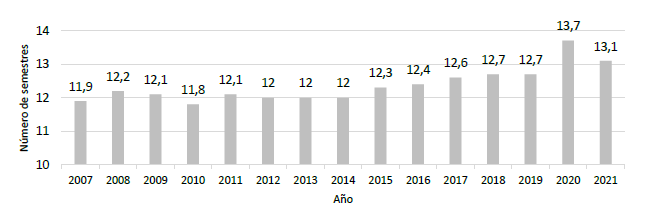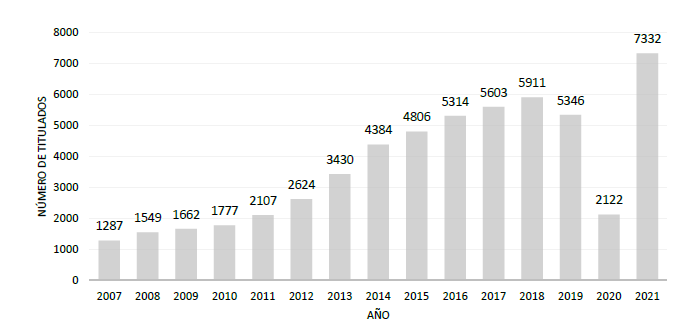Introduction
Nursing corresponds to the largest occupational group in the health sector, representing 59% approximately; however, in 2018, worldwide, there was a deficit of nursing professionals close to 5.9 million; to reverse this scenario, the number of graduates would have to increase by 8% per year (WHO, 2020).
A report by the Organization for Economic Co-operation and Development (OECD, 2021) states that in 2019, the number of practicing nurses in Chile was 2.9 per 1,000 inhabitants, compared to the OECD average of 8.8.
A recently published study shows that the average ratio of nursing personnel in Chile was 14 patients per nursing professional (Simonetti et al., 2020); in contrast to countries such as Norway with 5.2, Ireland with 6.9, Holland 7.0, Finland 7.6, Sweden 7.6, England 8.8, Belgium 10.8 or even compared to the European country with the highest ratio: Spain with 12.7 patients per nursing professional (Zabalegui Yárnoz, 2014). This is especially relevant when studies show that an improvement in the number of nursing professionals at the intra-hospital level in Chile is associated with lower mortality, higher patient satisfaction, fewer readmissions, and shorter hospital stays (Aiken et al., 2021).
Internationally, a study of 300 hospitals in nine countries reported that every increase of one patient per nurse professional is associated with a rise of 7% in the likelihood of a surgical patient dying within 30 days of admission; additionally, for every 10% increase in the percentage of nursing graduates in a hospital, it is associated with a 7% decrease in the likelihood of mortality (Aiken et al., 2014), thus, highlighting the importance of nursing for global public health both in numbers and in education.
However, globally, according to WHO (2020), there is a considerable variety in theoretical and practical nursing education and the occupational area. At present, in Chile, there are no updated reports that analyze the national reality of nursing. Therefore, in this scenario, the present article was designed to analyze the number of enrolled students, duration, number of graduates, professional training, and salary of nurses in Chile.
1. Methods
Reflection article based on the bibliographic methodology, whose sample used was a documentary, consulting the databases of the Higher Education Information Service (SIES by its acronym in Spanish) of Chile’s Ministry of Education (MINEDUC), which are of free access. The study variables were: I. Number of students enrolled in nursing; II. Standard and actual duration of education; III. Number of graduates; and finally, IV. Professional training and salary.
The period analyzed was from 2007 to 2022, varying by data availability.
With the sample already defined, descriptive statistics were used for data analysis and processing using Microsoft 365, Excel version 2011.
2. Results
2.1 Nursing enrollment in Chile
From the records dating back to 2007, 4,177 students were identified as enrolled in the nursing program, which increased considerably to 9,560 students enrolled in 2012 (SIES, 2016), below, in Graph 1 the pattern maintained in recent years can be seen (SIES, 2017, 2018, 2019, 2020, 2021a, 2022b), considering 6000 as the base.
2.2 Standard and actual period of nursing education in Chile.
In Chile, pursuant to Article 112 of the Decree with Force of Law number 725, “only those who possess the respective degree granted by the University of Chile or another university recognized by the State and are legally authorized to practice their professions may perform activities related to medicine, dentistry, chemistry and pharmacy or others related to the preservation and restoration of health” (1968, p.45).
In order to be able to analyze the duration of nursing education in Chile, it is important to understand two concepts: The standard or expected duration, which corresponds to the time determined by the institution that it should take each student to obtain the degree; while the actual duration corresponds to the number of academic semesters and year in which a student entered the first year of the program and the semester and year in which the student graduated (Ministry of Education, 2014).
In Chile, the standard or expected duration of nursing is 10 semesters (5 years); however, the actual duration is approximately 12 semesters (6 years), a value that has presented an upward pattern (SIES, 2021b), as shown in Figure 2 below.
2.3 Graduated nursing professionals
In the analyzed period since 2007, an increasing pattern is displayed in the number of nursing graduates, highlighting the year 2018 with the highest value before the COVID-19 pandemic, with a total of 5,911 graduates, and then two years with a decline and a peak in the year 2021 (SIES, 2021c). Hereinafter, Graph 3 shows the data distributed by year.
2.4 Nursing professional training and salaries
In terms of professional training, an increase has been visualized since 2017, wherein the first year of graduation, nursing obtained professional training of 73.1% and in the second year 91.3%; the latest available data date from the year 2021, with values of 97.9% in the first year and 98.1% in the second year. In terms of salary, the income received in the first year estimated through the average of the cohorts of graduates in 2018, 2019 and 2020 is $1,210,316 CPL per month, equivalent to $1,513 USD (estimated in March 2023), a figure that gradually increases to reach an income in the fifth year of $1,683,147 CPL (2,104 USD) average figures for the cohorts of 2014, 2015 and 2016 (SIES, 2022a).
3. Discussion
Nursing education in the Americas region is very heterogeneous since in Chile it corresponds to 5 years as well as in Bolivia, Cuba, Colombia, El Salvador, Guatemala, Honduras, and Peru; however, this number begins to decrease gradually, for example its duration was reduced to 4 years in Belize, Brazil, Jamaica, Mexico, Panama, Paraguay, Dominican Republic, Trinidad and Tobago, and Uruguay; followed by 3 years in most Caribbean countries, Ecuador and Venezuela (Cassiani et al., 2020).
In terms of the number of nursing graduates, Chile has been showing an upward pattern since 2007, with a peak in 2018 and then in 2021, in line with almost all OECD countries, where the number of nursing professionals per capita grew from an average of 7 per 1000 inhabitants in 2000 to 8.8 per 1000 inhabitants in 2019 (OECD, 2021), which may reflect the results of policy efforts in the face of a professional deficit scenario, both now and in the future.
However, despite the growth in the number of nursing graduates in the Americas region, a significant lag in the ratio of nursing professionals to technical and auxiliary personnel has been reported (S. Cassiani et al., 2018). This situation was aggravated during the pandemic, since due to technical, economic, and family issues, desertion of nursing students was described (Cedeño Tapia et al., 2021), in addition to the deaths of these professionals due to COVID-19 (CIE, 2020).
With respect to salary, nursing in the fifth year of graduation reached an average income of $2,104 USD; according to the 2017 OECD report, with 2015 figures, in Mexico and Chile, hospital nurses earned almost twice the average salary, being the two countries with the highest nursing compensation of the countries evaluated, a pattern kept in 2017 (OECD, 2019), as well as in the latest OECD report that shows data for 2019 (OECD, 2021).
This study provides a profile of nursing in Chile, data that has not been compiled or analyzed to date, thus generating a contribution that allows international comparison. However, it is not without limitations, as there is an absence of information classified by gender, which affects its analysis; this is especially important when the presence of the glass ceiling phenomenon in nursing has been described, where women nurses have more difficulties than men in ascending in their careers, with an apparent etiology marked merely by gender (Valencia-Contrera & Orellana Yáñez, 2022), which translates into salary differences; a situation consistent with what has been described in the United States, where it has been stated that registered nurses' salaries have stagnated since 2015 and with a gender wage gap that has been maintained, with male nurses better paid at all levels and in all roles (Potera, 2021).
Hence, as a consideration for future studies, it is suggested to investigate the role of gender of nursing professionals in their professional training and salaries; in addition to understanding the actual duration of training in Chile, since 2008, training has lasted approximately 12 semesters (six years), which was aggravated after the COVID-19 pandemic.
Conclusion
In this article, the objective was to analyze the number of enrolled students, duration, number of graduates, professional training, and salary of nursing in Chile, concluding that in the year 2022, there were 6,958 students enrolled; the standard duration in nursing is ten semesters, while the actual term is approximately 12 semesters. Regarding the number of graduated professionals, an upward pattern was evidenced in the analyzed period, presenting its maximum peak in the year 2018 with 5,911 and in the year 2021 with 7,332; in the year 2021, the nursing estate presented a professional training of 97.9% in the first year and the second year 98.1%, presenting a salary of $2.104 USD per month at the fifth year of graduation, which is one of the highest in the region. However, no data allows analyzing its distribution according to gender, but it is important to study that since an unfavorable panorama has been described.
Author contributions
Conceptualization, M.V.C.; data curation, M.V.C., R.A.I., F. R. R. and J.V.V.; investigation, M.V.C., R.A.I., F. R. R. and J.V.V.; methodology, M.V.C., R.A.I., F. R. R. and J.V.V.; project administration, M.V.C.; resources, M.V.C., R.A.I., F. R. R. and J.V.V.; software, M.V.C., R.A.I., F. R. R. and J.V.V.; supervision, M.V.C.; validation, M.V.C., R.A.I., F. R. R. and J.V.V.; visualization, M.V.C., R.A.I.,
F. R. R. and J.V.V.; writing-original draft, M.V.C., R.A.I., F. R. R. and J.V.V.; writing-review and editing, M.V.C., R.A.I., F. R. R. and J.V.V.


















